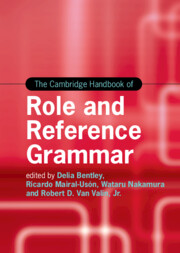Book contents
- The Cambridge Handbook of Role and Reference Grammar
- Cambridge Handbooks in Language and Linguistics
- The Cambridge Handbook of Role and Reference Grammar
- Copyright page
- Dedication
- Contents
- Figures
- Tables
- Contributors
- Pedagogical Guide to The Cambridge Handbook of Role and Reference Grammar
- Introduction
- Part One Overview
- Part Two Topics in RRG: Simple Sentences
- Part Three Topics in RRG: Complex Sentences
- 13 The Structure and Semantics of Complex Sentences
- 14 Linking Syntax and Semantics in Adverbial (Adjoined) Clauses
- 15 Cleft Sentences and Relative Clauses
- 16 Extraction Restrictions in Complex Sentences
- Part Four Applications of RRG
- Part Five Grammatical Sketches
- Index
- References
16 - Extraction Restrictions in Complex Sentences
from Part Three - Topics in RRG: Complex Sentences
Published online by Cambridge University Press: 08 June 2023
- The Cambridge Handbook of Role and Reference Grammar
- Cambridge Handbooks in Language and Linguistics
- The Cambridge Handbook of Role and Reference Grammar
- Copyright page
- Dedication
- Contents
- Figures
- Tables
- Contributors
- Pedagogical Guide to The Cambridge Handbook of Role and Reference Grammar
- Introduction
- Part One Overview
- Part Two Topics in RRG: Simple Sentences
- Part Three Topics in RRG: Complex Sentences
- 13 The Structure and Semantics of Complex Sentences
- 14 Linking Syntax and Semantics in Adverbial (Adjoined) Clauses
- 15 Cleft Sentences and Relative Clauses
- 16 Extraction Restrictions in Complex Sentences
- Part Four Applications of RRG
- Part Five Grammatical Sketches
- Index
- References
Summary
This chapter deals with the Role and Reference Grammar (RRG) approach to extraction restrictions, or island constraints. The cross-linguistic and language-internal (i.e. cross-constructional) variation in extraction restrictions is captured in RRG in terms of how deeply into sentence structure assertion may be represented. Some languages allow the potential focus domain to reach individual constituents in both complement and adverbial subordinate clauses, with consequences on the extractability of such constituents. One such case is Japanese, a more permissive language than English, which provides the main case study discussed in the chapter.
Keywords
- Type
- Chapter
- Information
- The Cambridge Handbook of Role and Reference Grammar , pp. 616 - 644Publisher: Cambridge University PressPrint publication year: 2023



